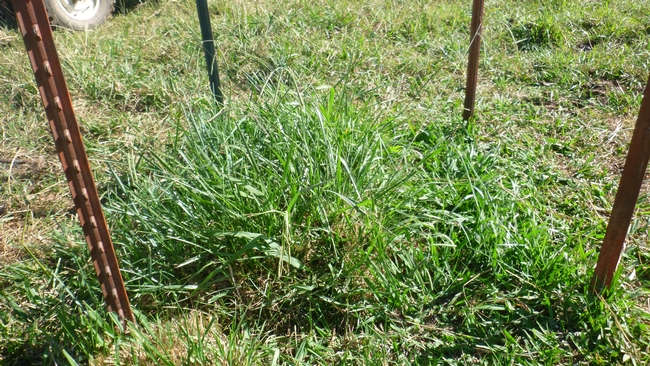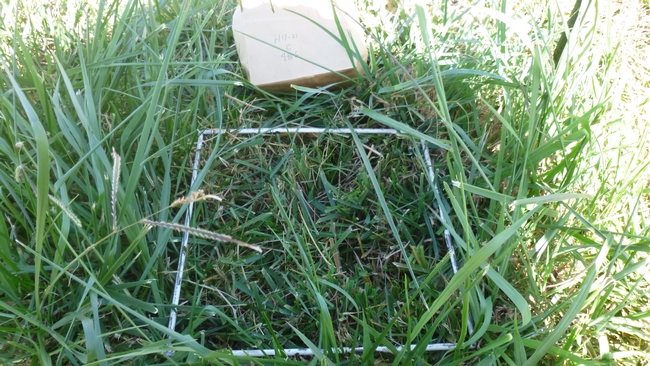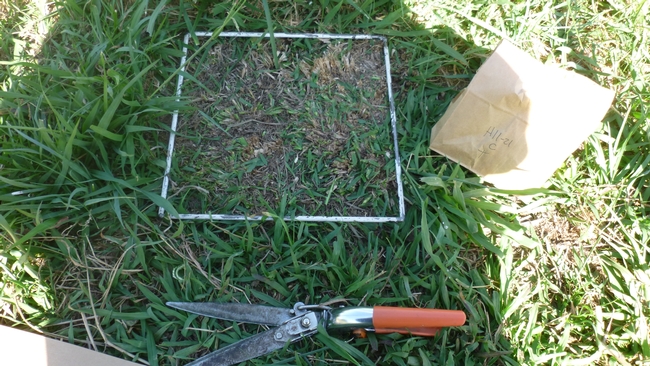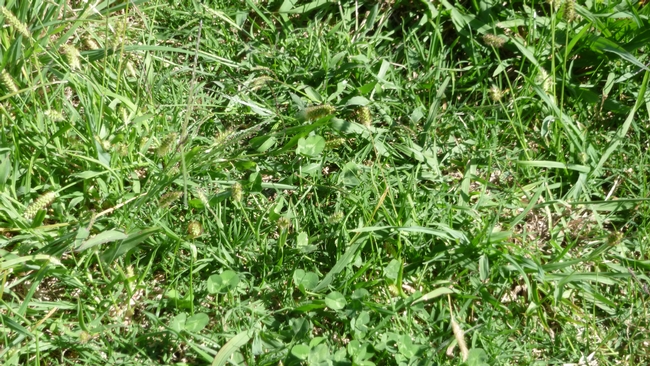By Nikolai Schweitzer
The Sierra Foothill Research and Extension Center in Browns Valley, CA utilizes 130 acres of summer irrigated pasture for cattle grazing. SFREC's irrigation water is supplied by a local water district via pipelines and open ditch distribution sources. The irrigation delivery system applies water through sprinklers, open ditches, and gated pipes. Each irrigated pasture at SFREC is managed for 1) Forage Production, 2) Water Quality, and 3) Soil Quality.

Figure 1: H11-21, Cage B, 4-6 inches treatment on the left and Total Forage Production treatment on the right. Photo credit: Nikolai Schweitzer
SFREC staff measures forage production in 15 enclosed cages throughout five different irrigated pastures. The treatments within each cage include leaving 4-6 inches of residual grass and measuring Total Forage Production (TFP). Guidelines for general irrigation and pasture management production based on past and current research recommend leaving 4 to 6 inches of residue/grass growth after each grazing period. The basis of this recommendation is to increase forage production (by leaving increased amounts of foliar surface area), improve root development, decrease weeds, cause less stress for forage grasses and increase water infiltration. Total Forage Production is measured by clipping the grass all the way to the ground. This center project is measuring the two treatments (4-6 inches & TFP) on their respective pounds/acre production. Each month (from April through October) forage is clipped from each cage, dried, and weighed (pounds/acre). After the samples are clipped, each enclosed area is leveled to its prescriptive treatment.

Figure 2: H11-21, Cage B removed. Photo credit: Nikolai Schweitzer

Figure 3: H11-21, Cage B. Measuring forage production leaving 4-6 inches. Photo credit: Nikolai Schweitzer

Figure 4: H11-21, Cage B. Measuring Total Forage Production. Photo credit: Nikolai Schweitzer

Fagure 6: SFREC irrigated forage production in 2016. TFP (Total Forage Production), 4 to 6 (Amount of forage left standing). By Nikolai Schweitzer
During the last two years of field sampling on irrigated pasture at SFREC, there was an increase in forage diversity in the Total Forage Production subplot. Clovers, birdsfoot trefoil, and filaree became increasingly abundant due to the increased sunlight and less crowding from competitive grasses. While the increase in clover and other forbes growth lends to an increase in forage quality, there is an overall decrease in forage production per acre in the TFP treatments when compared to the treatments with 4-6 inches of residual grass.

These treatments are not the only thing that affect forage growth, instead numerous factors can impact irrigated pasture forage growth. Fertilization (rates, composition, timing), irrigation (frequency, amount, duration), grazing (stocking density, class/age of animal), species composition, physical structures (water location, loafing areas, rubbing zones, mineral location), soil properties, aspect, and slope, are other important components to manage or consider.
Source:ucanr.edu